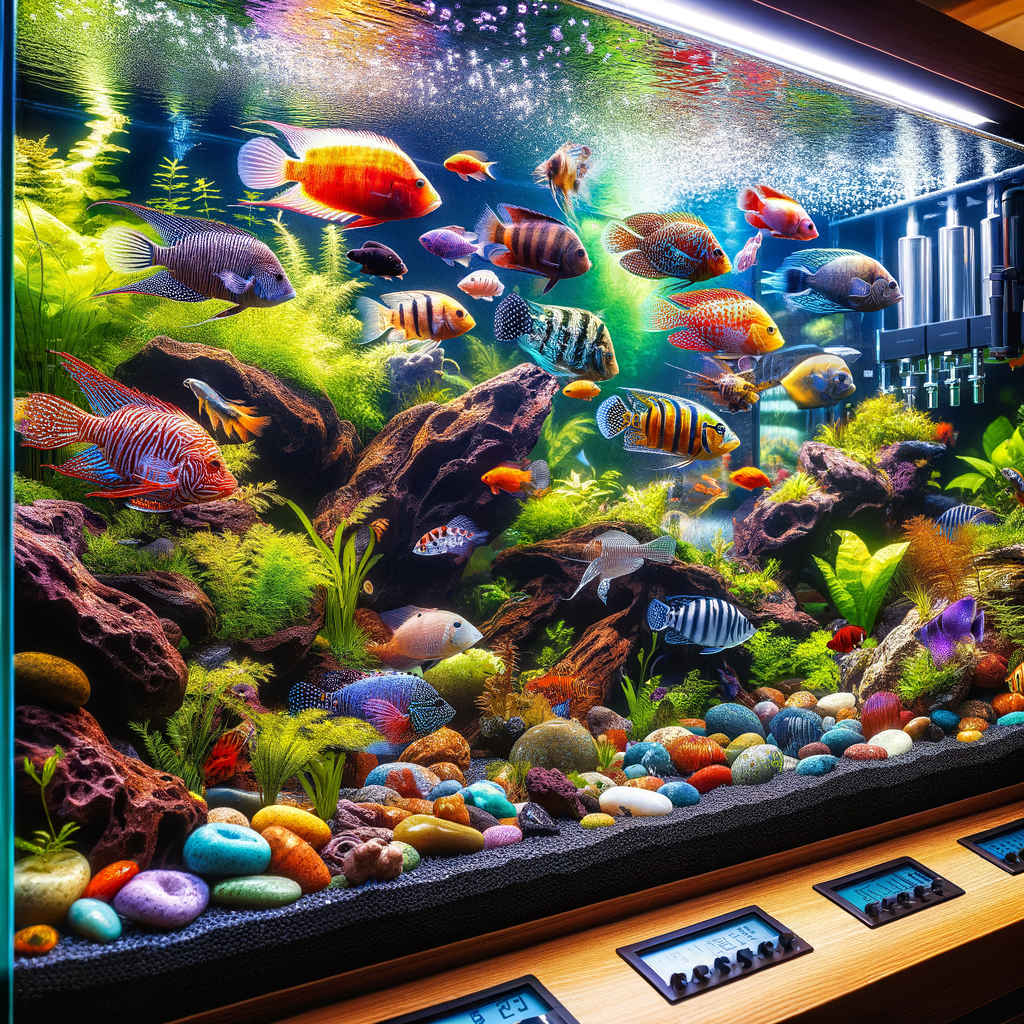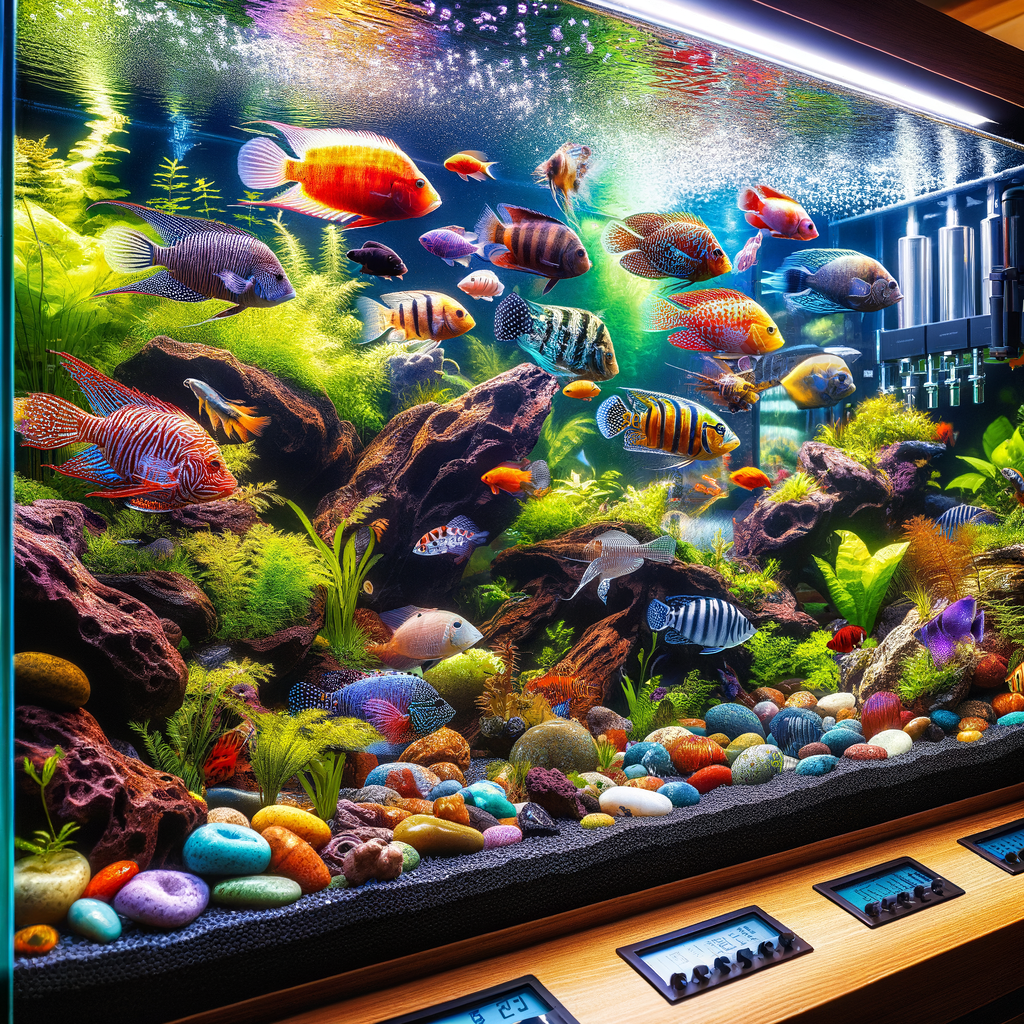
Introduction to Exotic Fish Aquarium Setup
Setting up an aquarium for exotic fish can be an exciting adventure. However, it requires careful planning and understanding of the basics. This guide will help you understand the essentials of setting up an aquarium for exotic fish, the importance of proper setup, and key factors to consider for exotic fish care.
-
- Understanding the Basics of Aquarium Setup for Exotic Fish
Setting up an aquarium for exotic fish is not as simple as filling a tank with water and adding fish. It involves understanding the specific needs of the fish species you plan to keep. This includes the right size of the tank, the type of water (freshwater or saltwater), the temperature, and the pH level. It’s also important to consider the type of substrate, plants, and decorations that will create a comfortable and natural environment for the fish.
-
- Importance of Proper Setting Up Fish Tank
A properly set up fish tank is crucial for the health and well-being of your exotic fish. An improper setup can lead to stress, disease, and even death. For instance, a tank that is too small can restrict the movement of the fish and lead to aggressive behavior. Similarly, the wrong water temperature or pH level can make the fish susceptible to diseases. Therefore, it’s important to research and plan carefully before setting up your fish tank.
-
- Key Factors to Consider in Exotic Aquarium Fish Care
Caring for exotic fish requires attention to several key factors. These include feeding the right diet, maintaining the water quality, providing a suitable environment, and monitoring the fish for signs of illness. Exotic fish often have specific dietary needs, so it’s important to provide a varied diet that meets their nutritional requirements. Regular water changes and testing are essential to maintain the water quality. Providing hiding spots and plenty of space to swim can help reduce stress and promote healthy behavior. Finally, regular observation can help you detect any signs of illness early and seek veterinary care if needed.
Setting up an aquarium for exotic fish can be a rewarding experience if done correctly. It requires understanding the basics, proper setup, and attentive care. With the right knowledge and preparation, you can create a beautiful and healthy environment for your exotic fish.
Planning Your Tropical Fish Aquarium Setup
Setting up a tropical fish aquarium is an exciting venture. However, it requires careful planning and consideration. Let’s delve into the key aspects you need to consider when planning your aquarium setup.
Choosing the Right Location
- Considerations for selecting the perfect spot
The location of your aquarium plays a crucial role in the health and wellbeing of your fish. Choose a spot that is away from direct sunlight, drafts, and heavy traffic. The location should also be near a power source for the aquarium’s equipment. - Examples of ideal and poor locations
Ideal locations include a quiet corner in your living room or study. Poor locations would be near windows, doors, or heating and air conditioning vents. - Understanding the relationship between tank size and fish health
The size of your tank directly affects the health of your fish. Larger tanks provide more space for fish to swim and better water quality, which is vital for their health. - Examples of suitable tank sizes for different exotic fish species
A 20-gallon tank is suitable for small species like Guppies and Tetras, while larger species like Angelfish and Discus require a 55-gallon tank or larger. - Filters and their importance in maintaining water quality
Filters are essential for maintaining water quality. They remove waste and toxins, providing a clean and healthy environment for your fish. - Heaters and their role in tropical fish aquarium setup
Heaters maintain the water temperature in the aquarium. Tropical fish require a consistent water temperature, typically between 75 and 80 degrees Fahrenheit. - Lighting and its impact on fish and plant health
Proper lighting is essential for the health of your fish and plants. It helps plants photosynthesize and provides a natural environment for your fish. - Air pumps and their benefits
Air pumps provide oxygen for your fish and help circulate the water, which aids in maintaining water quality. - CO2 systems for planted tanks
CO2 systems are essential for planted tanks. They provide the necessary carbon dioxide for plants to photosynthesize and grow. - Overview of popular exotic fish species
Popular exotic fish species include Guppies, Tetras, Angelfish, and Discus. Each species has its own unique care requirements. - Key care requirements for each species
Each species has specific care requirements. For example, Guppies need a diet rich in protein, while Angelfish require a varied diet and plenty of hiding spots. - Factors to consider when selecting fish
When selecting fish, consider their size, diet, temperament, and care requirements. Ensure that the fish species are compatible with each other and the aquarium setup. - Examples of good and bad fish combinations
Good combinations include Guppies with Tetras, while bad combinations would be Angelfish with small, aggressive species like Tiger Barbs. - Importance of regular water changes
Regular water changes are vital for maintaining water quality. They help remove waste and toxins, providing a clean and healthy environment for your fish. - How to properly clean your aquarium
Clean your aquarium regularly by removing any algae, changing the water, and cleaning the filter. Avoid using soap or detergents as they can harm your fish. - Identifying and treating common fish diseases
Common fish diseases include Ich and Fin Rot. If you notice any signs of disease, such as spots or changes in behavior, seek advice from a vet or pet store. - Dealing with algae problems
Algae can be a common problem in aquariums. Regular cleaning, proper lighting, and adding algae-eating fish can help control algae growth. - Recap of the essential steps in setting up an exotic fish aquarium
In summary, setting up an exotic fish aquarium involves choosing the right location, selecting the appropriate tank size, installing necessary equipment, choosing compatible fish species, and maintaining water quality through regular cleaning and water changes. - Final tips for successful aquarium setup and maintenance
Remember to research each fish species’ care requirements, monitor water quality regularly, and provide a varied diet for your fish. With careful planning and regular maintenance, you can create a thriving environment for your tropical fish.








